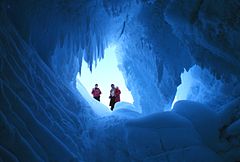 Do you think Antarctica is nothing but ice? There is a lot more than that. But today I want to talk about ice caves. Specifically the ice caves of Mount Erebus. Mount Erebus is the southernmost volcano in the world. It is an extremely active volcano that constantly spits up lava and hot gas.
Do you think Antarctica is nothing but ice? There is a lot more than that. But today I want to talk about ice caves. Specifically the ice caves of Mount Erebus. Mount Erebus is the southernmost volcano in the world. It is an extremely active volcano that constantly spits up lava and hot gas. The central chamber of most volcanoes is molten rock. For most volcanoes cooled, solid rock covers the center keeping the melted rock from boiling over. At Mount Erebus the center is a lake of magma bubbles at the top of the volcano. It extends down for possibly miles and the temperature is 1,700 degrees Fahrenheit.
Mount Erebus is near McMurdo Station, the main research base of the United States in Antarctica. Scientists have been monitoring the volcano. From November to January the temperatures can reach up to 5 degrees. Often because of high winds, the researchers have to stay in their camp until weather clears. They may only have a couple of days out of a week to actually visit the volcano.
As the volcano emits gases and blobs of lava, the cold air and snow almost immediately cools them. These emissions are what makes the caves and fumaroles. Fumaroles are more like chimneys than caves.
The temperatures inside the caves remain fairly constant at 32 degrees Fahrenheit. Researchers are wondering if they will find life that can survive the coldness in the caves.
If you would like to see some pictures of the caves there are links below.
Copas
Inside Antarctica's Caves
Best Of Ice Caves
Ice Towers and Caves
Aren't they the most beautiful formations? ...and that colour...wow.
ReplyDeleteI was awed by them. Some of the formations have glass with ice on it. Humans just can't duplicate these things and have them look this way.
ReplyDeleteI'd love to visit Antarctica to explore the caves. The colours are incredible :-)
ReplyDeleteEven though I'm not much of a spelunker, I'd like to see them too. What an adventure that would be.
ReplyDeleteAntarctica is on my list of places I would love to visit and explore someday.
ReplyDeleteExploring is what life's all about.
ReplyDeleteI had no idea there were volcanoes in Antarctica. Not to mention, you would think that the entire surface of the continent would no longer be covered with ice considering their presence there.
ReplyDeleteThe hot-cold thing is interesting to ponder. I was reading today that one of the many Alaskan volcanoes is about to erupt.
ReplyDelete